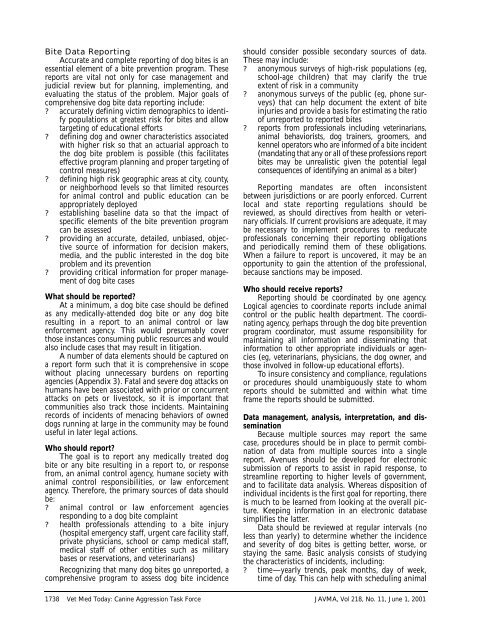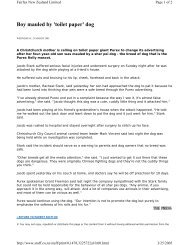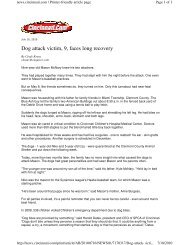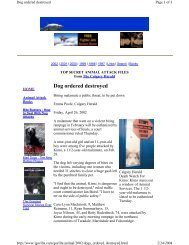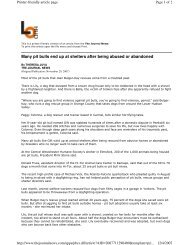A community approach to dog bite prevention - American Veterinary ...
A community approach to dog bite prevention - American Veterinary ...
A community approach to dog bite prevention - American Veterinary ...
Create successful ePaper yourself
Turn your PDF publications into a flip-book with our unique Google optimized e-Paper software.
Bite Data Reporting<br />
Accurate and complete reporting of <strong>dog</strong> <strong>bite</strong>s is an<br />
essential element of a <strong>bite</strong> <strong>prevention</strong> program. These<br />
reports are vital not only for case management and<br />
judicial review but for planning, implementing, and<br />
evaluating the status of the problem. Major goals of<br />
comprehensive <strong>dog</strong> <strong>bite</strong> data reporting include:<br />
? accurately defining victim demographics <strong>to</strong> identify<br />
populations at greatest risk for <strong>bite</strong>s and allow<br />
targeting of educational efforts<br />
? defining <strong>dog</strong> and owner characteristics associated<br />
with higher risk so that an actuarial <strong>approach</strong> <strong>to</strong><br />
the <strong>dog</strong> <strong>bite</strong> problem is possible (this facilitates<br />
effective program planning and proper targeting of<br />
control measures)<br />
? defining high risk geographic areas at city, county,<br />
or neighborhood levels so that limited resources<br />
for animal control and public education can be<br />
appropriately deployed<br />
? establishing baseline data so that the impact of<br />
specific elements of the <strong>bite</strong> <strong>prevention</strong> program<br />
can be assessed<br />
? providing an accurate, detailed, unbiased, objective<br />
source of information for decision makers,<br />
media, and the public interested in the <strong>dog</strong> <strong>bite</strong><br />
problem and its <strong>prevention</strong><br />
? providing critical information for proper management<br />
of <strong>dog</strong> <strong>bite</strong> cases<br />
What should be reported?<br />
At a minimum, a <strong>dog</strong> <strong>bite</strong> case should be defined<br />
as any medically-attended <strong>dog</strong> <strong>bite</strong> or any <strong>dog</strong> <strong>bite</strong><br />
resulting in a report <strong>to</strong> an animal control or law<br />
enforcement agency. This would presumably cover<br />
those instances consuming public resources and would<br />
also include cases that may result in litigation.<br />
A number of data elements should be captured on<br />
a report form such that it is comprehensive in scope<br />
without placing unnecessary burdens on reporting<br />
agencies (Appendix 3). Fatal and severe <strong>dog</strong> attacks on<br />
humans have been associated with prior or concurrent<br />
attacks on pets or lives<strong>to</strong>ck, so it is important that<br />
communities also track those incidents. Maintaining<br />
records of incidents of menacing behaviors of owned<br />
<strong>dog</strong>s running at large in the <strong>community</strong> may be found<br />
useful in later legal actions.<br />
Who should report?<br />
The goal is <strong>to</strong> report any medically treated <strong>dog</strong><br />
<strong>bite</strong> or any <strong>bite</strong> resulting in a report <strong>to</strong>, or response<br />
from, an animal control agency, humane society with<br />
animal control responsibilities, or law enforcement<br />
agency. Therefore, the primary sources of data should<br />
be:<br />
? animal control or law enforcement agencies<br />
responding <strong>to</strong> a <strong>dog</strong> <strong>bite</strong> complaint<br />
? health professionals attending <strong>to</strong> a <strong>bite</strong> injury<br />
(hospital emergency staff, urgent care facility staff,<br />
private physicians, school or camp medical staff,<br />
medical staff of other entities such as military<br />
bases or reservations, and veterinarians)<br />
Recognizing that many <strong>dog</strong> <strong>bite</strong>s go unreported, a<br />
comprehensive program <strong>to</strong> assess <strong>dog</strong> <strong>bite</strong> incidence<br />
should consider possible secondary sources of data.<br />
These may include:<br />
? anonymous surveys of high-risk populations (eg,<br />
school-age children) that may clarify the true<br />
extent of risk in a <strong>community</strong><br />
? anonymous surveys of the public (eg, phone surveys)<br />
that can help document the extent of <strong>bite</strong><br />
injuries and provide a basis for estimating the ratio<br />
of unreported <strong>to</strong> reported <strong>bite</strong>s<br />
? reports from professionals including veterinarians,<br />
animal behaviorists, <strong>dog</strong> trainers, groomers, and<br />
kennel opera<strong>to</strong>rs who are informed of a <strong>bite</strong> incident<br />
(mandating that any or all of these professions report<br />
<strong>bite</strong>s may be unrealistic given the potential legal<br />
consequences of identifying an animal as a <strong>bite</strong>r)<br />
Reporting mandates are often inconsistent<br />
between jurisdictions or are poorly enforced. Current<br />
local and state reporting regulations should be<br />
reviewed, as should directives from health or veterinary<br />
officials. If current provisions are adequate, it may<br />
be necessary <strong>to</strong> implement procedures <strong>to</strong> reeducate<br />
professionals concerning their reporting obligations<br />
and periodically remind them of these obligations.<br />
When a failure <strong>to</strong> report is uncovered, it may be an<br />
opportunity <strong>to</strong> gain the attention of the professional,<br />
because sanctions may be imposed.<br />
Who should receive reports?<br />
Reporting should be coordinated by one agency.<br />
Logical agencies <strong>to</strong> coordinate reports include animal<br />
control or the public health department. The coordinating<br />
agency, perhaps through the <strong>dog</strong> <strong>bite</strong> <strong>prevention</strong><br />
program coordina<strong>to</strong>r, must assume responsibility for<br />
maintaining all information and disseminating that<br />
information <strong>to</strong> other appropriate individuals or agencies<br />
(eg, veterinarians, physicians, the <strong>dog</strong> owner, and<br />
those involved in follow-up educational efforts).<br />
To insure consistency and compliance, regulations<br />
or procedures should unambiguously state <strong>to</strong> whom<br />
reports should be submitted and within what time<br />
frame the reports should be submitted.<br />
Data management, analysis, interpretation, and dissemination<br />
Because multiple sources may report the same<br />
case, procedures should be in place <strong>to</strong> permit combination<br />
of data from multiple sources in<strong>to</strong> a single<br />
report. Avenues should be developed for electronic<br />
submission of reports <strong>to</strong> assist in rapid response, <strong>to</strong><br />
streamline reporting <strong>to</strong> higher levels of government,<br />
and <strong>to</strong> facilitate data analysis. Whereas disposition of<br />
individual incidents is the first goal for reporting, there<br />
is much <strong>to</strong> be learned from looking at the overall picture.<br />
Keeping information in an electronic database<br />
simplifies the latter.<br />
Data should be reviewed at regular intervals (no<br />
less than yearly) <strong>to</strong> determine whether the incidence<br />
and severity of <strong>dog</strong> <strong>bite</strong>s is getting better, worse, or<br />
staying the same. Basic analysis consists of studying<br />
the characteristics of incidents, including:<br />
? time—yearly trends, peak months, day of week,<br />
time of day. This can help with scheduling animal<br />
1738 Vet Med Today: Canine Aggression Task Force JAVMA, Vol 218, No. 11, June 1, 2001


